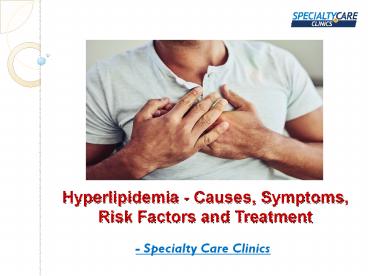Hyperlipidemia - Causes, Symptoms, Risk Factors and Treatment - PowerPoint PPT Presentation
Title:
Hyperlipidemia - Causes, Symptoms, Risk Factors and Treatment
Description:
Does your doctor ever ask you about your family history of Hyperlipidemia? Find out the causes, symptoms, risk factors and treatment of this medical condition. – PowerPoint PPT presentation
Number of Views:25
Slides: 7
Provided by:
Username withheld or not provided
Category:
Medicine, Science & Technology
Tags:
Title: Hyperlipidemia - Causes, Symptoms, Risk Factors and Treatment
1
Hyperlipidemia - Causes, Symptoms, Risk Factors
and Treatment
- - Specialty Care Clinics
2
What is Hyperlipidemia?
- High cholesterol level is a common problem among
Americans. Almost 1 in 3 people in the United
States suffer from high cholesterol levels. This
is medically also referred to as hyperlipidemia.
A high level of cholesterol indicates you have
too many fats in your blood. Even though
hyperlipidemia can be acquired, it's mostly
considered the result of lifestyle factors,
including unbalanced eating habits and too
minimal actual work. - The most well-known kind of hyperlipidemia is
high cholesterol. Different types of
hyperlipidemia incorporate hypertriglyceridemia
and blended hyperlipidemia, in which both
cholesterol and fatty oil levels are high. - Your cholesterol can be "dysfunctional" that
involves very inflammatory cholesterol particles
or an abnormal balance between bad and good
cholesterol levels, without being high. Both an
elevated degree of cholesterol and expanded
aggravation in "typical" cholesterol levels put
you at expanded risk for coronary illness.
3
What Causes Hyperlipidemia?
- Cholesterol, a waxy substance, is a sort of fat
your body makes. It can likewise come from what
you eat. - Food sources that have cholesterol, soaked fat,
and trans fats can raise your blood cholesterol
level. These include - Cheese.
- Egg yolks.
- Fried and processed foods.
- Ice cream.
- Pastries.
- Red meat.
4
- How to Identify Hyperlipidemia?
- In the United States, 94 million individuals over
the age of 20 have raised absolute cholesterol
levels. This adds up to around 50 of all U.S.
grown-ups. - Individuals with untreated hyperlipidemia are two
times as liable to foster coronary course
infection (CAD) as those with cholesterol levels
in the typical reach. This can prompt obstructed
conduits, which can set off respiratory failure,
stroke, or other significant issues. - For the most part, individuals with
hyperlipidemia experience no side effects. Be
that as it may, those with familial, or acquired
hyperlipidemia, may develop yellow, greasy
developments around the eyes or joints. A
specialist for the most part recognizes
hyperlipidemia during a normal blood test or
following a cardiovascular occasion, for example,
a coronary episode or stroke. - Extreme development of fat over the long haul can
cause atherosclerosis. This is when plaques
create on the dividers of the veins and veins and
tighten the openings. - Get More Details Information Click Here
5
Contact Us
- Website https//specialtycareclinics.com/
- Contact No. 469-545-9983
- Email hugosutton020_at_gmail.com
6
Thank You






























